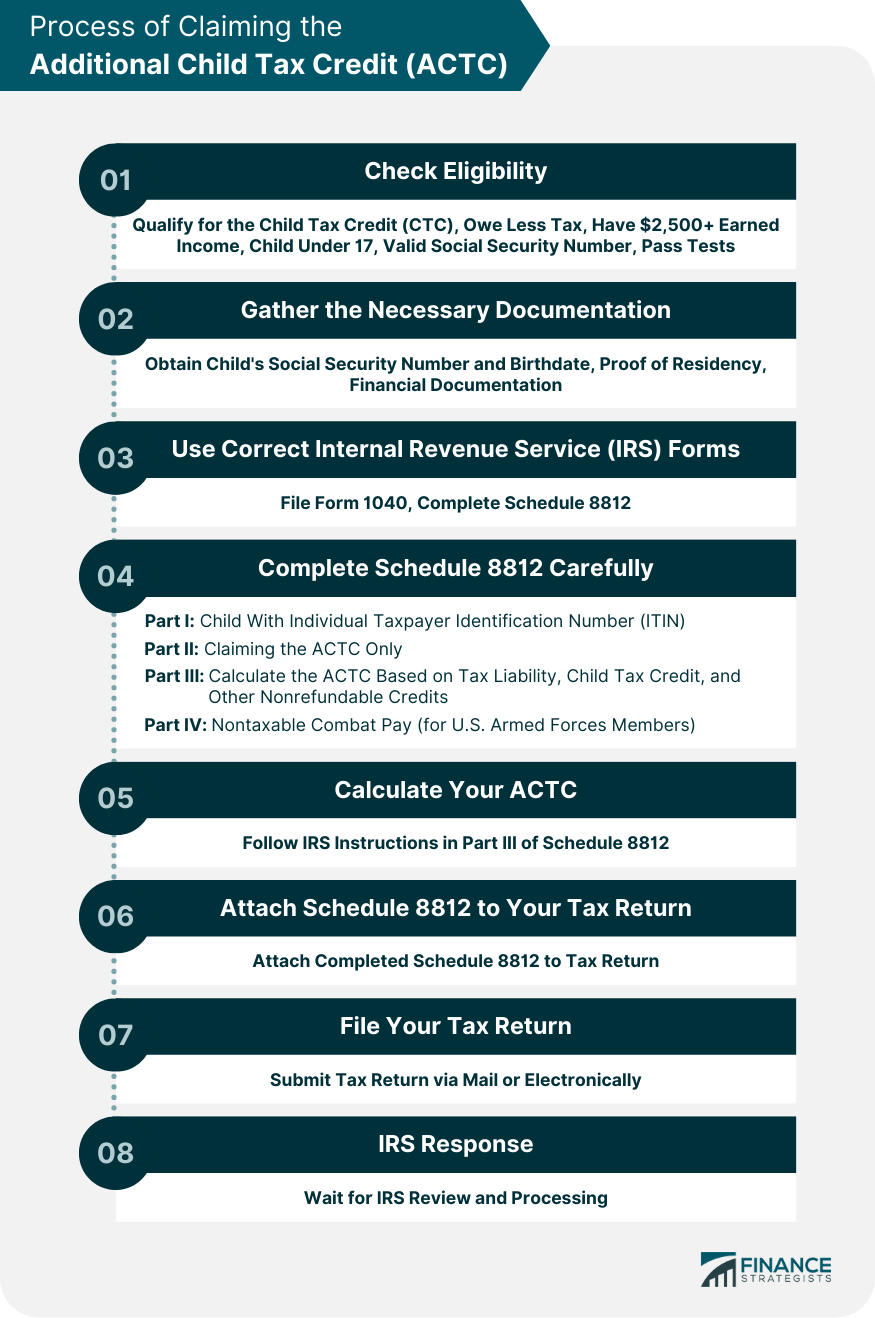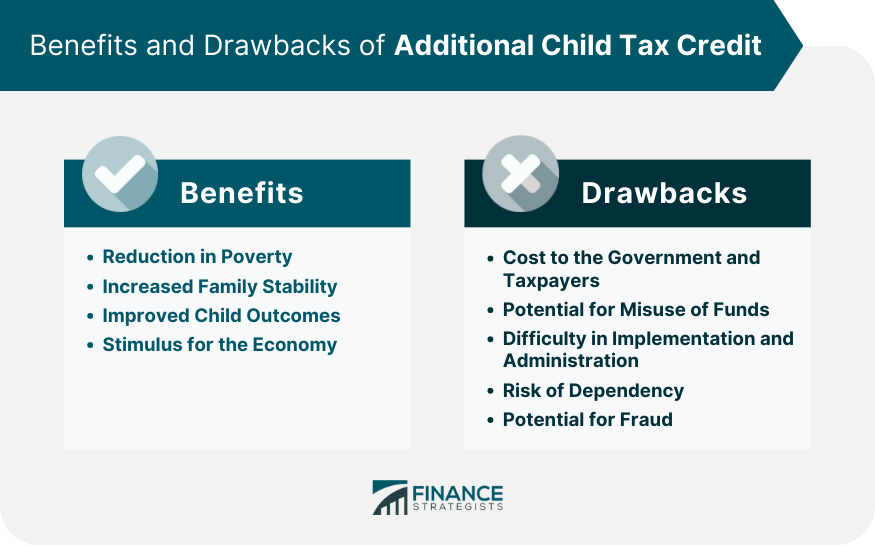The Additional Child Tax Credit (ACTC) is a refundable credit that provides financial assistance to families with children. The ACTC allows taxpayers to receive a refund even if they owe less in taxes than the credit's value. It is designed to supplement the Child Tax Credit (CTC), aiding families who might only benefit partially from the non-refundable CTC due to low income. The ACTC allows low-income families to receive a partial or full refund of the Child Tax Credit, helping them cover the costs of raising children. Any taxpayer can claim the ACTC with a qualifying child who did not receive the full amount of the Child Tax Credit. The taxpayer must also have earned income above a specific threshold for the tax year. To be eligible for the ACTC, you first need to qualify for the Child Tax Credit (CTC) but not be able to claim the full amount because your owed tax is less than your potential credit. Apart from this, you should have at least $2,500 in earned income. Also, each child you're claiming must be under 17, have a valid Social Security number, and must pass certain tests related to relationship, support, dependent status, and residency. Before you begin the process, make sure you have all the necessary documentation. This will include the Social Security numbers and dates of birth for each qualifying child. Proof of residency for each child, and financial documentation such as W-2s or 1099s to prove your earned income, will be required. When you file your federal income tax return, you'll use IRS Form 1040. But if you're claiming the ACTC, you'll also need to complete Schedule 8812 (Additional Child Tax Credit). This schedule is specifically for calculating the amount of the ACTC. Schedule 8812 has four parts: Part I is for those with a child who has an Individual Taxpayer Identification Number (ITIN). Part II is for those who are claiming the ACTC only. Part III allows you to calculate the ACTC. Here, you will determine the amount of your credit by comparing your total tax liability to your Child Tax Credit (line 19 of Form 1040) and any other nonrefundable credits you may have. If your total credits are less than your total tax, you may be able to claim the ACTC. Part IV is where you list any nontaxable combat pay if you're a member of the U.S. Armed Forces. After filling out the first three parts of Schedule 8812, you will calculate your credit in Part III. Here, the IRS will guide you through a series of calculations to determine your ACTC. You can't claim more than you're eligible for, but this process will ensure that you claim the maximum you're allowed. Once you've filled out Schedule 8812 completely and accurately, you will attach it to your federal tax return. It's important to double-check all your figures and your math before you submit it. After attaching Schedule 8812, you're ready to file your tax return. You can do this through the mail or electronically. If you qualify for the ACTC, the amount of the credit will first be used to reduce your tax debt. If the credit exceeds your tax, you may get the excess amount as a refund. Once your tax return is filed, all you have left to do is to wait for a response from the IRS. They will review your return and, if everything is in order, process your refund. In specific circumstances, non-custodial parents may be able to claim the ACTC if they meet certain criteria, including a written declaration from the custodial parent allowing them to claim the child as a dependent. Immigrant families may also claim the ACTC if they meet eligibility requirements. Children must have a valid Social Security number, while parents can use an Individual Taxpayer Identification Number (ITIN) to file their tax return. Families with special needs children may qualify for additional tax benefits, such as the Credit for Other Dependents and the ACTC. By providing supplemental financial resources to families, it helps cover the cost of basic necessities. This extra financial aid can make a significant difference in the lives of families who are on the brink of poverty, keeping children fed, clothed, and housed. By raising families out of poverty, the Child Tax Credit can also alleviate the long-term negative effects of poverty on children, such as cognitive development delays and lower educational achievement. This stability may lead to a reduction in stress and anxiety related to financial concerns, thereby improving the mental and emotional health of parents and children alike. This can foster healthier family dynamics and living conditions, reducing the likelihood of conflicts and instability within the household. These include enhanced performance in school, better health outcomes, and improved mental health. Furthermore, some studies have shown that this supplemental income can lead to higher future earnings as adults, indicating a positive long-term impact of the tax credit. When families receive more disposable income, they are more likely to spend it. This can lead to increased consumption of goods and services, which in turn supports businesses and leads to job creation. This increased economic activity can stimulate the overall economy and contribute to economic growth. Given that the Additional Child Tax Credit is refundable, the government might be in a situation where it pays out more in credits than it receives in taxes from lower-income individuals. This can exert strain on the government budget and potentially contribute to a higher national debt, which may necessitate increases in taxes or reductions in other government services. While the goal is to assist in covering child-related expenses, there are no strict controls on how the money is spent. This might lead to the money being used for non-essential purchases or for purposes not directly benefiting the child. The risk of both overpayments (where people receive more than they're entitled to) and underpayments (where people don't receive as much as they should) can be high. This can lead to inefficiencies and frustrations that undermine the effectiveness of the tax credit. There is a concern that certain welfare programs could foster dependency, potentially discouraging recipients from seeking upward mobility or improving their financial situation independently. If families come to rely heavily on the Additional Child Tax Credit, it may hinder motivation to seek better employment or further education. As with any tax credit system, the Additional Child Tax Credit could be susceptible to fraudulent claims. If rigorous checks are not in place, some individuals might take advantage of the system, leading to funds being wrongly allocated and those genuinely in need potentially missing out. The Additional Child Tax Credit is a valuable program that provides financial assistance to families with children, particularly those with low incomes. By offering a refundable credit, the ACTC ensures that families receive support even if their tax liability is lower than the credit's value. This assistance helps cover the costs of raising children, reduces poverty, and improves family stability. Furthermore, the ACTC has positive long-term effects on children's outcomes, such as enhanced school performance and better overall health. While the ACTC stimulates the economy through increased consumption and job creation, there are concerns about the cost to the government and taxpayers, potential misuse of funds, challenges in implementation and administration, the risk of dependency, and the potential for fraudulent claims. Addressing these concerns will be essential to maximize the effectiveness and fairness of the ACTC.What Is the Additional Child Tax Credit?
Process of Claiming the Additional Child Tax Credit
Check Your Eligibility
Gather the Necessary Documentation
Use the Correct IRS Forms
Complete Schedule 8812 Carefully
Calculate Your ACTC
Attach Schedule 8812 to Your Tax Return
File Your Tax Return
Wait for IRS Response

Additional Child Tax Credit in Special Circumstances
Non-Custodial Parents
Immigrant Families
Families With Special Needs Children
Benefits of Additional Child Tax Credit
Reduction in Poverty
Increased Family Stability
Improved Child Outcomes
Stimulus for the Economy
Drawbacks of Additional Child Tax Credit
Cost to the Government and Taxpayers
Potential for Misuse of Funds
Difficulty in Implementation and Administration
Risk of Dependency
Potential for Fraud

Conclusion
Additional Child Tax Credit FAQs
Any taxpayer can claim the ACTC if they have a qualifying child who did not receive the full amount of the Child Tax Credit and have earned income above a specific threshold for the tax year.
The ACTC can be up to 15% of the taxpayer's earned income over a set limit. However, the total amount of the ACTC and the Child Tax Credit claimed cannot exceed the total allowable Child Tax Credit.
To claim the ACTC, taxpayers need supporting documents such as social security numbers for each qualifying child, proof of relationship, and proof of residence for the qualifying child.
In specific circumstances, non-custodial parents may be eligible to claim the ACTC if they meet certain criteria, including obtaining a written declaration from the custodial parent allowing them to claim the child as a dependent.
Yes, immigrant families may be eligible for the ACTC if they meet the eligibility requirements. The children must have a valid Social Security number, while parents can use an Individual Taxpayer Identification Number (ITIN) to file their tax return.
True Tamplin is a published author, public speaker, CEO of UpDigital, and founder of Finance Strategists.
True is a Certified Educator in Personal Finance (CEPF®), author of The Handy Financial Ratios Guide, a member of the Society for Advancing Business Editing and Writing, contributes to his financial education site, Finance Strategists, and has spoken to various financial communities such as the CFA Institute, as well as university students like his Alma mater, Biola University, where he received a bachelor of science in business and data analytics.
To learn more about True, visit his personal website or view his author profiles on Amazon, Nasdaq and Forbes.











